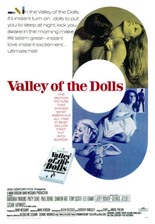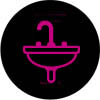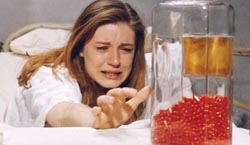
 As coined by Jacqueline Susann, the “dolls” of her 1966 breakthrough novel, Valley of the Dolls, were drugs — more specifically, pills: uppers and downers. The resulting ’67 film adaptation, which Susann despised, is nothing but up — a high from which there is no crash, unless you count the point when the movie just comes to an abrupt end. Its reputation as a camp classic is every bit deserved.
As coined by Jacqueline Susann, the “dolls” of her 1966 breakthrough novel, Valley of the Dolls, were drugs — more specifically, pills: uppers and downers. The resulting ’67 film adaptation, which Susann despised, is nothing but up — a high from which there is no crash, unless you count the point when the movie just comes to an abrupt end. Its reputation as a camp classic is every bit deserved.
“Dolls” also could describe the cautionary tale’s triumvirate of heroines:
• Anne (a bland Barbara Parkins, TV’s Peyton Place), a good girl with bad taste in men;
• Neely (a bonkers Patty Duke, Amityville 4: The Evil Escapes), a scrappy singer who goes from Broadway failure to Billboard chart-domination after performing on a cystic fibrosis telethon;
• and Jennifer (a diabolically gorgeous Sharon Tate, The Fearless Vampire Killers), who has little talent, but lotta breast, and uses it to her advantage.
 The girls respectively happen to end up, work her way up and sleep her way up to the top. But what goes up must come down, and in this showbiz-minded Valley of trashy entertainment, only the downward spiral counts, of course. Sex and booze sit on the Romper Room shelf compared to the damage done by pills. Catty and caustic, Neely takes to them like orange Tic-Tacs in her blood-, sweat- and tear-soaked bid to earn the title of America’s sweetheart and hold onto the sash, all in an industry more fickle than the public it spoon-feeds.
The girls respectively happen to end up, work her way up and sleep her way up to the top. But what goes up must come down, and in this showbiz-minded Valley of trashy entertainment, only the downward spiral counts, of course. Sex and booze sit on the Romper Room shelf compared to the damage done by pills. Catty and caustic, Neely takes to them like orange Tic-Tacs in her blood-, sweat- and tear-soaked bid to earn the title of America’s sweetheart and hold onto the sash, all in an industry more fickle than the public it spoon-feeds.
Arguably playing the most troubled of the trio, Duke bites into her addiction scenes with the intensity of swine flu. More or less a monologue muttered to herself on darkened city streets, her final scene finds Neely complaining through slurs that snowball into shouts (“Boobies, boobies, boobies! Nothin’ but boobies!”); Duke finishes so over-the-top, she’s to blame for the hole in the ozone layer. People talk of Neely’s wig-pulling of her has-been nemesis (Susan Hayward, I Married a Witch) as Dolls’ standout scene of first-degree lunacy, but I’d argue for this one instead.
Helmed with instantly dated style by Mark Robson, who shepherded an equally scandalous blockbuster novel to the screen a decade before with Peyton Place, the film is rushed even at two hours and three minutes; viewers may be confused that the passage of time goes unmarked, yet the trade-off is a breathless pace that staves even the threat of boredom. With fashion shoots, faux porn, Martin Milner, mental illness and a dash of homophobia, Valley of the Dolls is a textbook example of well-dressed melodrama that unintentionally begets comedy — a big, bubbly lather of a soap opera that only Hollywood could churn out: purely by accident. —Rod Lott
